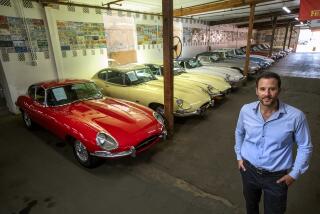Mullin Museum celebrates artistry by rest of the Bugatti family
- Share via
The Mullin Automotive Museum in Oxnard is always overflowing with rare, handmade, and expensive Bugattis from the gilded, prewar era.
But the Bugattis in the current exhibit have neither wheels nor engines. Turns out the Bugatti family’s talents extended well beyond cars.
Running until March 31, Mullin’s “The Art of Bugatti” adds an intriguing dimension to the family’s history. It explores prodigious artwork and talents of the entire Bugatti clan, which included ornate furniture, internationally renowned bronze sculpture, silversmithing and painting.
“Where else in history is there a family like this?” said Peter Mullin, founder of the museum that bears his name and owner of much of what’s on display inside.
Mullin’s avid car collecting -- he prefers prewar models from French marques like Voisin, Delage and Delahaye -- bled into furniture years ago. The 73-year-old’s research into Art Deco cars wandered to furniture from that era and the period before it, Art Nouveau.
“You can’t think about the Art Deco movement without thinking about furniture,” Mullin said. “I became interested because our museum is really not a car museum so much as it is an Art Deco museum with cars as centerpiece.”
In doing so, Mullin stumbled across Bugatti patriarch Carlo. The elder Bugatti earned a reputation -- and a considerable fortune -- as an artist and craftsman in the late 19th and early 20th centuries. He’s best known for his intricate wood furniture and musical instruments, though he also worked as a silversmith and painter.
Carlo, an Italian by birth, moved his wife Theresa and family to Paris at the turn of the 20th century. It was there that his children’s artistic careers flourished. His elder son Ettore had his automobiles, a business and craft that he later passed to his own son Jean. Ettore’s daughter Lidia was also a painter.
Meanwhile, Carlo’s younger son Rembrandt is regarded as an immensely talented sculptor. Known for his deep love of all creatures, his bronze animal statues were inspired by his time at the Antwerp Zoo in Belgium.
Yet he would eventually fall into a depression and financial hardship and commit suicide in 1916. Today, his pieces can command hundreds of thousands of dollars, if not millions, at auctions.
“It continues to amaze me that the breadth and depth of this family’s talents continued over multiple generations,” Mullin said.
And both Rembrandt and Carlo have pieces on display in museums throughout the globe, including the Musee d’Orsa in Paris. But you can save yourself a transcontinental flight by driving to Oxnard.
Tucked into each nook of the Mullin museum is art born from the hand of a Bugatti. Immediately to the right of the entrance is a wooden archway from 1900 that Carlo hand-carved. Head further inside the museum for his wood thrones, silk-fringed chairs and even an ornate banjo.
Three of Rembrandt’s notable bronze sculptures are on display: “Stalking Panther,” “American Bison” and “Walking Indian Elephant.” Upstairs are the original doors to the Bugatti workshop and numerous paintings by Lidia, some of the very family members the exhibit celebrates.
Throughout the exhibit there around 40 pieces of furniture by Carlo and dozens of sculptures by Rembrandt. There are also components of the Bugatti automobile factory in Mulsheim, France, and engine for a Bugatti-powered train, and photographs of much of the family’s history.
Of course, this being a car museum, plenty of attention is paid to the famed cars built by Ettore and Jean (full name Gianoberto Carlo Maria Augusto). These four-wheeled monuments to impeccable design and cutting-edge technology are reason enough to pay the museum a visit.
Highlights include a light-blue 1936 Type 57SC Atlantic, a car which grabbed the Best of Show award at the 2003 Pebble Beach Concours d’Elegance. It’s one of only two such cars in the world -- the other belongs to Ralph Lauren. Yes, that Ralph.
There’s also a pair of cars related to the very creation of the Bugatti brand. A gleaming silver 1908 Bugatti Type 10 prototype built by Ettore in his basement foreshadows production models he would later sell.
And the tiny 1913 Peugeot Bebe Cabriolet is also on display, a design of Ettore’s that he licensed to Peugeot, which provided an influx of cash to the fledgling Bugatti brand.
Visitors also shouldn’t miss (and probably can’t, given the car’s size) the Type 41 Royale Coupe De Ville. Measuring a massive 21 feet long, the black-and-gray beast was displayed at the 1928 Paris Auto Show as the most expensive car ever built.
Perched on the grille of this model is an elaborate radiator cap in the form of an elephant on its hind legs, a sculpture by Ettore’s brother Rembrandt that would become the brand’s symbol.
Luck was not on this model’s side, however; the Great Depression soon followed and Bugatti sold only three of the six models built.
Mullin (the man) spent about a year putting the exhibit together and getting all the items in one place. He owns most of what visitors see, though a few choice pieces of art and the odd car were lent to the museum for the exhibit.
Some items come directly from the Bugatti family itself. Mullin knew Ettore’s granddaughter Caroline personally from various road rallies. When he approached her with the idea for this exhibit, she eagerly lent him family correspondence and paintings that had never been shown publicly.
After the exhibit closes at Mullin’s museum in March, he expects that portions of it will travel to other museums for further exhibits. The talent of the Bugatti family and their achievements are too expansive not to share with the public.
“It seems kind of criminal to just pack all this up and say ‘That’s it,’ ” Mullin said. Those who want to see the collection in its entirety in Oxnard, however, have until March 31 to check it out.







